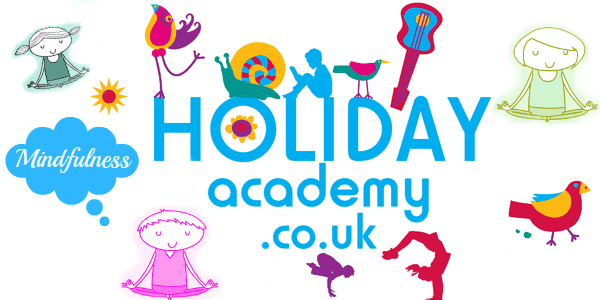Image source: www.coachingyciberoptimismo.blogspot.co.uk, www.eomega.org
Mindfulness for kids
Mindfulness has proven to be beneficial for adults (especially parents!). It allows parents to engage better with their parenting and provides the tools to allow for a calmer home environment :) Children will, of course, also feel the stress of everyday life and mindfulness exercise can benefit them in the same way. This is why we have children’s yoga in the Holiday Academy programme – relaxing is fun! There is emerging research that indicates that mindfulness activities can improve attention span, calmness and it helps better decision making. So what is mindfulness actually? In short, it makes emotional regulation and cognitive focus easier. Mindfulness is ‘awareness’ – noticing thoughts, feeling bodily sensations and what is around us and happening right now.
Mindful Parenting
Mindful parenting is non judgmental. To incorporate mindfulness everyday, it’s good to start with a daily meditation, yoga or breathing practice. The purpose of teaching children mindfulness is to give them skills to develop their awareness of their inner and outer experiences, to recognize their thoughts as ‘just thoughts’, to understand how emotions manifest in the body and to provide tools for impulse control. To teach children (or any one for that matter) it’s worth practicing mindfulness yourself and mediation just 5-10 minutes a day. Find out more about mindfulness for adults here...
Image Source: www.thephysicaleducator.com
7 Ways to Teach Mindfulness to Kids
Bell Listening Exercise – This is an easy way for children to practice mindfulness.Ring a bell and ask your children to listen closely to the ringing sound until they can no longer hear it (usually takes 30 seconds to a minute). When they no longer can hear the bell ask them to tell you what sounds they noticed when they listened to the bell. This exercise is not only fun but it helps them connect to the present moment and the sensitivity of their perceptions.
1. Breathing Buddies – Give your children a soft toy as a breathing buddy and ask them to lie down on their backs with their ‘buddy’ on their belly. Instruct them to breath in silence for one minute and notice how their breathing buddy moves up and down. Ask them to focus their attention to the movements of their buddy and tell them to imagine that the thoughts that come into their minds turn into bubbles and float away.
2. Mindful walks – Make your walks mindful. When going for a walk with your children try to point out things in your surrounding that you have not noticed before. Designate one minute to walk in complete silence and simply pay attention to all the sounds around.
3. Gratitude exercises – Gratitude is a fundamental component of mindfulness. During family dinners have a moment of gratitude for your food. This simple dinner exercise teaches your children to appreciate the abundance in their lives.
4. The art of touch – Give your children different objects to touch, such as a ball, a feather, a soft toy or a stone, etc. Ask them to close their eyes and describe what the object feels like. This mindfulness exercise teach the kids the practice of isolating their senses from one another, and tuning into distinct experiences.
5. Mindful eating – Mindful eating is an experience that engages all the five senses. Tell your children to look, smell, taste and touch the food. By using all their senses your children will appreciate all of the characteristic of the food. They are more likely to savour the bites, eat slower, digest better and enjoy the meal more. You can find more about mindful eating here.
6. Smell & Tell – Pass something fragrant to your little one It could be anything from a piece of fresh orange peel or a spring from a jasmine flower, as long as it is pleasant and fragrant it should do. Ask them to close their eyes and breath in the scent, focusing all their attention to only the smell of the object. This is a great exercise as scent can really be a great tool for anxiety relief among other things.
7. The Heartbeat Exercise – This is a fun exercise that everyone will enjoy. Ask them to jump up and down in one place for one minute. Then ask them to sit back down and place their hands on their hearts, tell them to close their eyes and feel their heartbeats and their breath. You can also ask what else they notice about their bodies.
The most important thing is to remember to have fun and keep it simple. Some of the exercises will work and some won’t. If your children aren’t interested in one particular exercise, drop it, this will be a good time for you to practice non- attachment outcomes!
References:
www.mindful.org
www.huffingtonpost.com
www.mindbidygreen.com
www.blog.harvardvanguard.org
www.huffingtonpost.com


